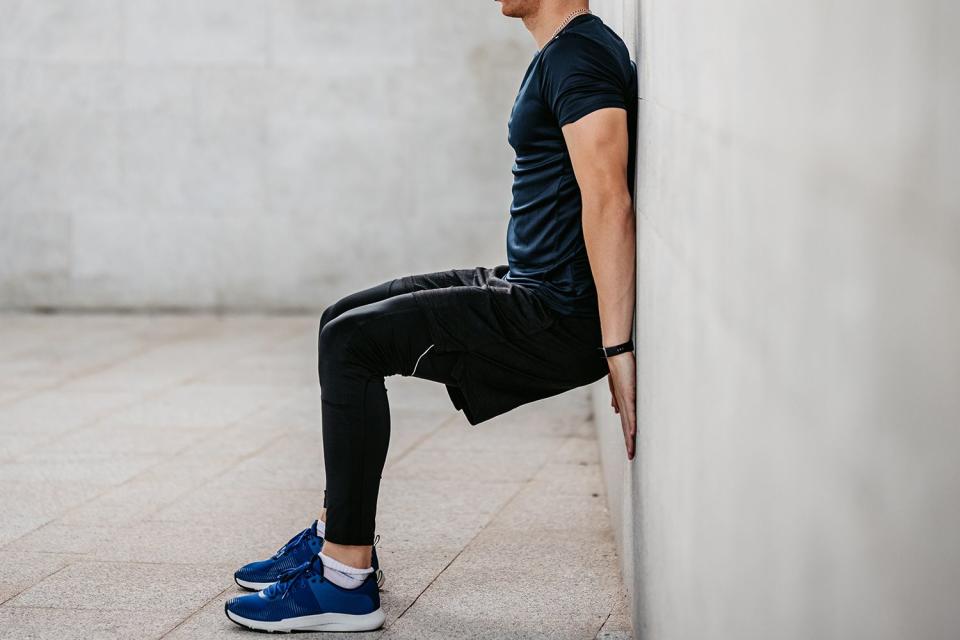8 Minutes of This No-Sweat Exercise Can Lower Blood Pressure Better Than Cardio
Isometric exercises like wall sits are “the most effective” at reducing blood pressure, a report says

Getty
Wall sits are a type of isometric exercise.Low-impact isometric exercises, like wall sits, may be better at lowering your overall blood pressure than running on a treadmill.
A report in the British Journal of Sports Medicine compared how different forms of exercise impacted blood pressure. Included were aerobic exercise training (like running), dynamic resistance training (like push-ups or weight-training), combined training (which engages several muscle groups at once), high-intensity interval training (known as HIIT, characterized by bursts of intense exercise) and isometric exercise — which the Mayo Clinic explains is “tightening (contractions) of a specific muscle or group of muscles.”
Examples include leg lifts, planks, and wall sits — or wall squats, as they’re sometimes called — which the report specifically mentioned.
The report found that “isometric exercise training remains the most effective mode” at reducing blood pressure.

Getty
A patient has their blood pressure tested.Blood pressure is measured by two numbers, the CDC explains. Systolic blood pressure, the first number, measures the pressure in your arteries when your heart beats. The pressure in your arteries when your heart rests is the second number, called diastolic.
Isometric exercise best reduced systolic pressure, while running reduced diastolic the most. However, isometric was overall the standout in decreasing pressure, the report found.
Never miss a story — sign up for PEOPLE's free daily newsletter to stay up-to-date on the best of what PEOPLE has to offer, from celebrity news to compelling human interest stories.
But while isometric exercises may be most effective, the study’s authors don’t suggest that you drop your entire workout routine and only do wall squats.
“Our main message is that actually engaging in exercise is fantastic and any exercise might reduce your blood pressure,” said Jamie O’Driscoll, the senior author of the study, told The Washington Post.
Related: 2024 Apple Watch to Monitor Blood Pressure and Detect Sleep Apnea: Report
“But if you’re an individual who is currently exercising to the guidelines and you’re still having a bit of difficulty reducing that blood pressure and you want to avoid going on medication, perhaps isometrics is an additional mode to complement the exercise you’re already doing.”
As The Washington Post explained, “eight minutes of isometric exercise, three times a week, can lead to a meaningful reduction in blood pressure.”
This could mean holding the “sit” pose for two minutes, then resting for two minutes, until you’ve completed 8 minutes of the isometric exercise.

Getty
Wall sits are a type of isometric exercise.All you need is a flat wall and the right form, as Verywell Fit explains “many people get it wrong.”
When squatting, make sure “your knees are directly above your ankles (rather than over your toes),” the outlet explains.
High blood pressure can “can seriously hurt important organs like your heart, brain, kidneys, and eyes,” the CDC says — but it can be managed to avoid health problems.
“There are other lifestyle changes as well as exercise that can benefit your blood pressure,” Joanne Whitmore, senior cardiac nurse at the British Heart Foundation, who wasn’t involved in the report, told CNN.
“These include keeping to a healthy weight, eating a balanced diet, cutting down on salt, not drinking too much alcohol and ensuring that you continue to take any prescribed medication.”
For more People news, make sure to sign up for our newsletter!
Read the original article on People.


